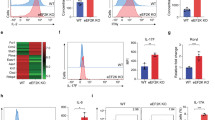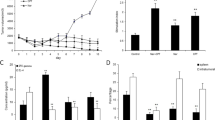Abstract
CD4+CD25+ regulatory T (Treg) cells maintain the function of immune tolerance and the balance of immune cells. Defects in the number and function of Treg cells can induce the development and progression of inflammatory disease. Shikonin, the main active ingredient of Lithospermum, has anti-inflammatory and anti-tumor effects. Shikonin is also an effective drug for the treatment of psoriasis, which is a chronic inflammatory skin disease. However, the underlying mechanism is not yet clear. To evaluate the role of shikonin on the induction of Treg cells, we tested the number and function of Treg cells in vivo and in vitro. Shikonin can effectively promote the differentiation of iTreg cells by inhibiting the AKT/mTOR pathway in vitro. Moreover, in vivo, intragastrically administered shikonin effectively improved lesions in mice with imiquimod-induced psoriasis and increased the number of iTreg cells in the spleen and their secretion. Shikonin significantly increases the expression of Foxp3mRNA in skin of the psorisic mice. Therefore, we expect that shikonin can prevent the development of inflammation and treat psoriasis by regulating iTreg cells. Novel ideas for the treatment of psoriasis are also proposed.







Similar content being viewed by others
References
Gershon, R.K. 1975. A disquisition on suppressor T cells. Transplantation Reviews 26: 170–185.
Azimi, M., S. Aslani, S. Mortezaqholi, et al. 2016. Identification, isolation, and functional assay of regulatory T cells. Immunological Investigations 45 (7): 584–602.
Li, X., and Y. Zheng. 2015. Regulatory T cell identity: formation and maintenance. Trends in Immunology 36 (6): 344–353.
Goodman, W.A., K.D. Cooper, and T.S. McCormick. 2012. Regulation generation: the suppressive functions of human regulatory T cells. Critical Reviews in Immunology 32 (1): 65–79.
Lee, H.M., J.L. Bautista, and C.S. Hsieh. 2011. Thymic and peripheral differentiation of regulatory T cells. Advances in Immunology 112: 25–71.
Huynh, A., R. Zhang, and L.A. Turka. 2014. Signals and pathways controlling regulatory T cells. Immunological Reviews 258 (1): 117–131.
Huynh, A., M. DuPage, B. Priyadharshini, P.T. Sage, J. Quiros, C.M. Borges, N. Townamchai, V.A. Gerriets, J.C. Rathmell, A.H. Sharpe, J.A. Bluestone, and L.A. Turka. 2015. Control of PI(3) kinase in Treg cells maintains homeostasis and lineage stability. Nature Immunology 16 (2): 188–196.
Moradi, B., P. Schnatzer, S. Hagmann, N. Rosshirt, T. Gotterbarm, J. Kretzer, M. Thomsen, H.M. Lorenz, F. Zeifang, and T. Tretter. 2014. CD4+CD25+/highCD127low/− regulatory T cells are enriched in rheumatoid arthritis and osteoarthritis joints—analysis of frequency and phenotype in synovial membrane, synovial fluid and peripheral blood. Arthritis Research & Therapy 16 (2): R97.
Ohl, K., and K. Tenbrock. 2015. Regulatory T cells in systemic lupus erythematosus. European Journal of Immunology 45 (2): 344–355.
Lord, J.D., D.M. Shows, J. Chen, and R.C. Thirlby. 2015. Human blood and mucosal regulatory T cells express activation markers and inhibitory receptors in inflammatory bowel disease. PLoS One 10 (8): e0136485.
Zhang, L., X.Q. Yang, J. Cheng, R.S. Hui, and T.W. Gao. 2010. Increased Th17 cells are accompanied by FoxP3(+)Treg cell accumulation and correlated with psoriasis disease severity. Clinical Immunology 135 (1): 108–117.
Bovenschen, H.J., I.M. van Vlijemen-willems, P.C. van de Kerkhof, and P.E. van Erp. 2006. Identification of lesional CD4+CD25+Foxp3+ regulatory T cells in psoriasis. Dermatology 213 (2): 111–117.
Sugiyama, H., R. Gyulai, E. Toichi, E. Garaczi, S. Shimada, S.R. Stevens, T.S. McCormick, and K.D. Cooper. 2005. Dysfunctional blood and target tissue CD4+CD25high regulatory T cells in psoriasis: mechanism underlying unrestrained pathogenic effector T cell proliferation. Journal of Immunology 174 (1): 164–173.
Kim, J., and J.G. Krueger. 2015. The immunopathogenesis of psoriasis. Dermatologic Clinics 33 (1): 13–23.
Xu, Y., X. Xu, X. Gao, H. Chen, and L. Geng. 2014. Shikonin suppresses IL-17-induced VEGF expression via blockage of JAK2/STAT3 pathway. International Immunopharmacology 19 (2): 327–333.
Liang, D., Y. Sun, Y. Shen, F. Li, X. Song, E. Zhou, F. Zhao, Z. Liu, Y. Fu, M. Guo, N. Zhang, Z. Yang, and Y. Cao. 2013. Shikonin exerts anti-inflammatory effects in a murine model of lipopolysaccharide-induced acute lung injury by inhibiting the nuclear factor-kappa B signaling pathway. International Immunopharmacology 16 (4): 475–480.
Lin, T.J., H.T. Lin, W.T. Chang, P. Mitapalli. S, P.W. Hsiao, S.Y. Yin, and N.S. Yang. 2015. Shikonin-enhanced cell immunogenicity of tumor vaccine is mediated by the differential effects of DAMP components. Molecular Cancer 14: 174.
Lee, C.C., J.J. Kang, B.L. Chiang, C.N. Wang, and Y.W. Cheng. 2011. Shikonin inhibited mitogen-activated IL-4 and IL-5 production on EL-4 cells through downregulation of GATA-3 and c-Maf induction. Life Sciences 89 (11–12): 364–370.
Haxhinasto, S., D. Mathis, and C. Benoist. 2008. The AKT-mTOR axis regulates de novo differentiation of CD4+Foxp3+ cells. The Journal of Experimental Medicine 205 (3): 565–574.
Sauer, S., L. Bruno, A. Hertweck, D. Finlay, M. Leleu, M. Spivakov, Z.A. Knight, B.S. Cobb, D. Cantrell, E. O'Connor, K.M. Shokat, A.G. Fisher, and M. Merkenschlager. 2008. T cell receptor signaling controls Foxp3 expression via PI3K, Akt, and mTOR. Proceedings of the National Academy of Sciences of the United States of America 105 (22): 7797–7802.
Kubo, R., S. Muramatsu, Y. Sagawa, C. Saito, S. Kasuya, A. Nishioka, E. Nishida, S. Yamazaki, and A. Morita. 2017. Bath-PUVA therapy improves impaired resting regulatory T cells and increases activated regulatory T cells in psoriasis. Journal of Dermatological Science 86 (1): 46–53.
Hau, C.S., T. Shimizu, Y. Tada, M. Kamata, S. Takeoka, S. Shibata, A. Mitsui, Y. Asano, M. Sugaya, T. Kadono, S. Sato, and S. Watanabe. 2018. The vitamin D3 analog, maxacalcitol, reduces psoriasiform skin inflammation by inducing regulatory T cells and downregulating IL-23 and IL-17 production. Journal of Dermatological Science 92 (2): 117–126.
Acknowledgements
This work was supported by the National Natural Science Foundation of China (81673055 and 81402595).
Author information
Authors and Affiliations
Corresponding author
Ethics declarations
All animal experimental procedures were approved and overseen by the Animal Care and Use Committee of the Shenyang Institute of Traditional Chinese Medicine.
Conflict of Interest
The authors declare that they have no conflict of interest.
Additional information
Publisher’s Note
Springer Nature remains neutral with regard to jurisdictional claims in published maps and institutional affiliations.
Rights and permissions
About this article
Cite this article
Zhang, X., Li, J., Yu, Y. et al. Shikonin Controls the Differentiation of CD4+CD25+ Regulatory T Cells by Inhibiting AKT/mTOR Pathway. Inflammation 42, 1215–1227 (2019). https://doi.org/10.1007/s10753-019-00982-7
Published:
Issue Date:
DOI: https://doi.org/10.1007/s10753-019-00982-7




